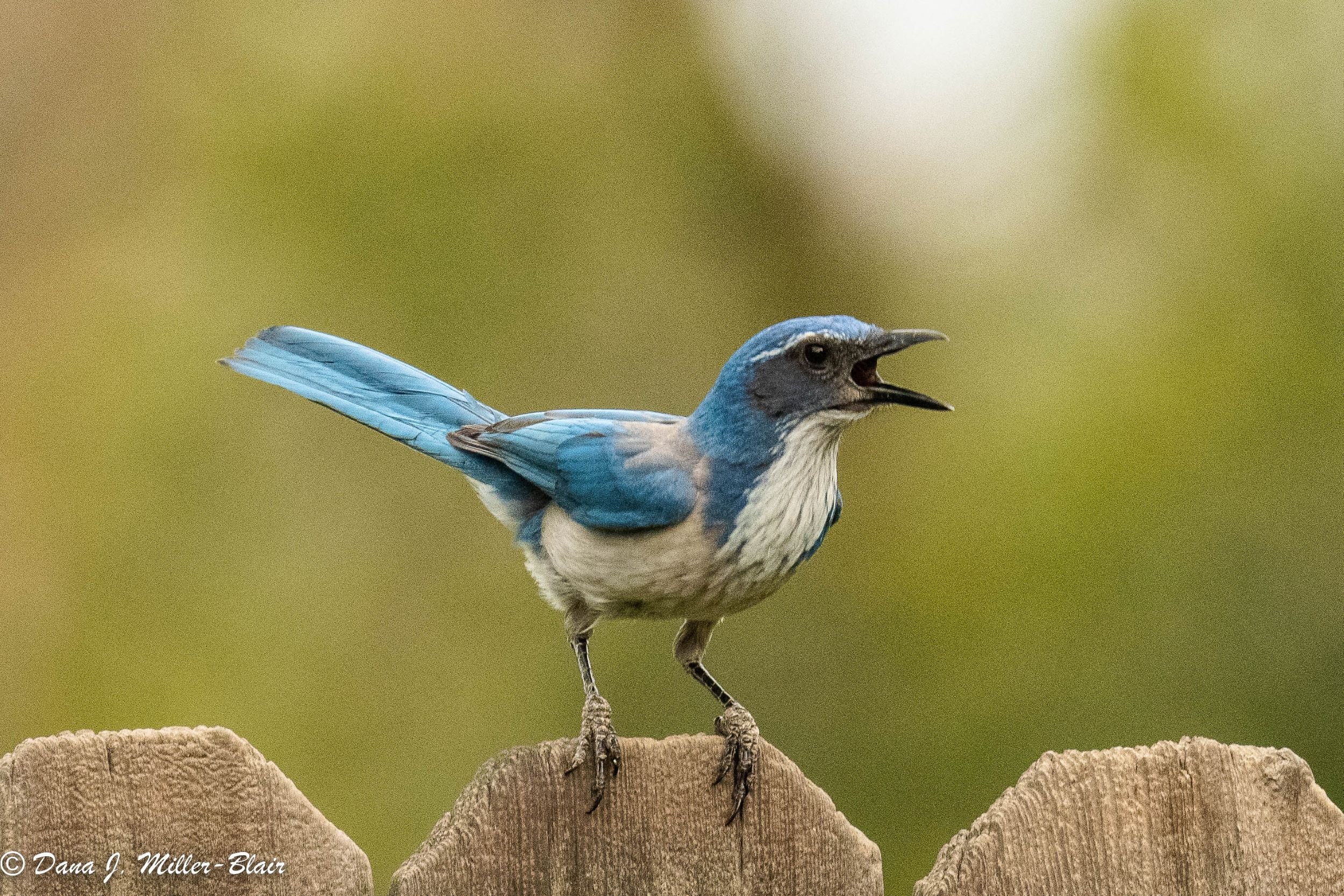California Scrub-jay, Adult, Image by Dana J. Miller-Blair
This month, let’s talk about a songbird called the California Scrub-Jay. California Scrub-Jays are frequently seen all year long in the Sacramento Valley. Their range is from the western coast of Canada down to the Baja Peninsula in Mexico and parts of Nevada. California Scrub-Jays are non-migratory which means they remain year-round in a permanent territory. Occasionally, it may be necessary for them to travel to find food if acorns and other foods become scarce where they live.
California Scrub-Jays are often incorrectly called Blue Jays; but the Blue Jay is a different species that is found east of the Rockies. There are at least 10 different species of jays living in North America! Another scrub-jay species, called the Woodhouse’s Scrub-Jay, is found in states to the east of California. This species looks extremely similar to the California Scrub-Jay. The two species, California and Woodhouse’s Scrub-Jays, used to be considered a single species; but were separated in 2016. All jay species are in the bird group or family, called Corvidae (corvids). Corvids include crows, ravens, jays, and magpies. Birds in this family are thought to be very intelligent!
You will often see California Scrub-Jays at the tops of high trees, keeping watch over their territory. They can be quite vocal and they frequently make their presence known!
What do California Scrub-Jays look like?
Both male and female California Scrub-Jays are bright blue, have a patch of grayish-brown on their backs, and have white on their throats and abdomens. Their heads are round; there isn’t a crest, which some other jay species have. California Scrub-Jays also have a blue band or ‘necklace’ that runs from their neck area diagonally into their chest area. They have a white ‘eyebrow’ line and have a black area around their eyes. California Scrub-Jays’ tails are long and they have long, thick bills that have a small hook at the end. Their specialized bills make it easy to carry and open up acorns so that they can eat what’s inside.
California Scrub-Jay nestlings start out totally gray. As they grow, the juvenile (or young) birds have gray heads and backs, a blue tail, and some blue on their wings. There is also a little blue on the forehead of the juvenile in the photo below.
California Scrub-Jay, Juvenile, Image by Daniel Lee Brown
Where do California Scrub-Jays live?
The habitat of California Scrub-Jays is quite variable; they are seen both around homes and in more remote areas. California Scrub-Jays are found in parks, pastures, neighborhoods, riverside woodlands, and oak scrublands. Pairs usually have a permanent territory and can be very protective of their area. They will chase out other jays (and sometimes other species of birds).
California Scrub-Jays nest in bushes and low trees, usually not more than 5 to 15 feet above the ground. Both the male and female build the nest and there is usually only one clutch (or group of eggs) per year. Some believe that it’s the female that does most of the nest building, while the male guards the nest area. California Scrub-Jay nests are cup-shaped, very sturdy, and are usually well hidden. They are made of grass, moss, and twigs and lined with tiny roots, plant fibers, and sometimes animal hair. It usually takes about ten days to build a nest. The female of the pair incubates the eggs (sits on and keeps the eggs warm) for 15-17 days. According to some researchers, the male brings food to the female during the incubation period. The nestlings (or baby birds) are fed by both parents. 18-22 days after hatching, juvenile birds leave the nest; but their parents continue to feed and watch over them for about a month until they learn to be independent.
What do California Scrub-Jays eat?
California Scrub-Jay, Adult, Image by Mary Forrestal
California Scrub-Jays eat a variety of foods and what they eat depends on where they live and what time of year it is. They look for food on the ground, in trees, and also will eagerly come to feeders. California Scrub-Jays eat mostly insects, spiders, and sometimes snails during spring and summer. They switch to acorns, nuts, berries, and grass seeds during fall and winter. California Scrub-Jays will also eat other animals’ eggs, small rodents, the young of other birds, small reptiles, and amphibians. Parents feed their young mainly moth caterpillars.
California Scrub-Jays, like other Corvids, are very clever or intelligent. They actually can plan for the future, an ability known as metacognition. California Scrub-Jays often bury acorns to eat in future months. They try to make sure there aren't any other animals watching when they bury them! California Scrub-Jays also have fantastic memories and can remember up to 200 places where they previously buried acorns! They do leave many acorns in the ground, however. This is the reason that the Miwok Indians call the Scrub-Jay ‘the one who plants oaks’. California Scrub-Jays can also be quite sneaky and will take stored acorns from Acorn Woodpeckers and other jays!
What do California Scrub-Jays sound like?
As stated above, California Scrub-Jays are quite vocal and often loud. They mainly use calls and rarely sing. Often pairs will communicate with each other using their typical harsh calls. Listen to the California Scrub-Jay now.
These calls and song of the California Scrub-Jay are from xeno-canto. More California Scrub-Jay vocalizations can be found at xeno-canto.org/species/Aphelocoma-californica.





